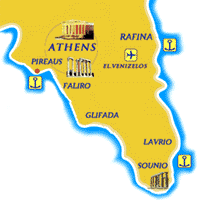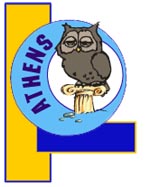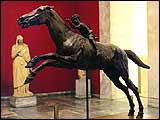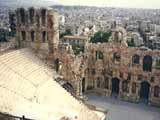|
Aegina
Athens
Agistri
Piraeus |
 |
 |
 |
Athens, the capital of Greece is
the city of the Olympic Idea, the city of culture, of science and commerce.
A city with ancient monuments like Acropolis, the inimitable ancient
monument and landmark of Greece, museums, lively tradition districts like
Plaka and numerous sights. These are some of the reasons that make Athens
worth visiting.
Temples of Acropolis
|
 |
The Parthenon: It is the most important
and characteristic monument of the ancient Greek civilization and still
remains its international symbol. It was dedicated to Athena Parthenos, the
patron goddess of Athens. It was built between 447 and 432 BC, to plans of
Iktinos and Kalikrates while Pheidias and his pupils had charge of general
constructional supervision and of the decorative carvings. It was the
first time that a peripheral temple in the Doric style was decorated all
round with a sculptured frieze 160 meters long, illustrating the
Panathenaean Procession (the most formal religious festival of ancient
Athens). The 92 metopes were also sculptured with reliefs representing a
battle with giants, a battle with amazons, battles with centaurs and scenes
from the Trojan War. The gold and ivory statue of the goddess Athena, the
work of Pheidias was set up in the interior. When construction of the temple
had been completed, the pedimental sculptures were added. The two pediments
of the temple are decorated with mythological scenes: the east, above the
building's main entrance, shows the birth of Athena, and the west, the fight
between Athena and Poseidon for the name of the city of Athens. |
 |
The
Acropolis Museum The museum was designed by the architect Panages Kalkos
and constructed between 1865 and 1874. In the 1950's it was extended towards
the east and the exhibition was rearranged by the archaeologist I. Meliades.
The museum contains mainly pedimental sculpture, reliefs and statues found
on the rock of the Acropolis, which formed part of the decoration of its
buildings or were dedicated to the goddess Athena. The collections of the
museum include: · Sculptural offerings of the Archaic period · Pediments of
temples dated to the Archaic period · Archaic Horsemen · Sculptures of the "Severe"
style · Pediments and metopes from the Parthenon · The Parthenon frieze ·
The Erechtheion frieze · Parapets of the Athena Nike temple · Frieze of the
Athena Nike temple · The Caryatids · Clay figurines and vases from the
sanctuary of the Nymphs
Theatre of Herod Atticus (The Herodion): Erected in 161BC by the
Athenian orator and benefactor whose name it commemorates. It can seat 5.000
spectators but most of its marble seats, except for those in the front row,
are modern restorations. It hosts all the events of the Athens Festival, as
well as a few other concerts and performs throughout the summer.
Stoa of Eumenes: Constructed in the 2nd c BC, it took its name from
the king of Pergamon, Eumenes II, who paid for it. Only its foundations
remain, but Athenians used to stroll and discuss in the shade of this 163m
long arcade.
Theatre of Dionysos: This theatre, which occupies the site of an earlier
sanctuary of Dionysos Eleuthereos, is considered to be the oldest yet
discovered. Of the original 5th c. BC structure, only the orchestra remains.
The movable stage and seats were of wood. It was here that the great dramas
of the Golden Age had their first performances. The stone seats were added
in the 4th c. BC. Measuring 100m in width, 90m in depth and possessing 78
rows of seats, of which only two-thirds are extant, the theatre underwent
many alterations before it reached its final form.
Odeon of Pericles: Completed in 443 BC. Its foundations have been only
partly excavated. This roofed building with columns was used as a concert
hall.
|
 |
|

